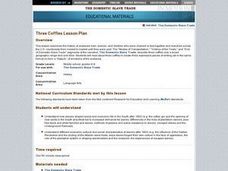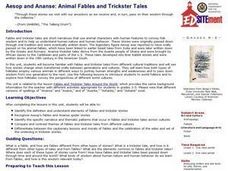Curated OER
Reliving History through Slave Narratives
Helpful for an American literature or history unit, this lesson prompts middle schoolers to examine slavery in the United States. They read slave narratives that were part of the Federal Writers' Project and then conduct their own...
Crafting Freedom
Sequencing of Events in the Slave Narrative of Henry "Box" Brown
What steps did Henry "Box" Brown take while planning his own escape from slavery? Learners work in groups to analyze segments of Brown's narrative and identify the sequence of the most important events of his story.
Crafting Freedom
Creating Original Historical Fiction Using Henry "Box" Brown's Narrative and Runaway Slave Ads
Young historians discover the experiences of runaway slaves after reading the brief biography and narrative excerpt of Henry "Box" Brown, who escaped slavery by having himself shipped away in a crate and popularized his flight in a...
K20 LEARN
Between The Lines: Inferences In The Narrative Life Of Frederick Douglass Excerpt
Good literature can be much like an iceberg requiring readers to presume that the bulk of the meaning may be inferred to be found below the surface. Here's a lesson that asks scholars to conduct a close reading of passages from The...
Curated OER
Three Coffles
Students read several slave narratives that comment on the ways in which slaves were transported from market to market. They write three original pieces expressing the viewpoint of a man, woman and child in captivity.
Curated OER
Frederick Douglass, Narrative of the Life of Frederick Douglass an American Slave, Written by Himself
Foster reader confidence when encountering complex text and reinforce the skills readers have acquired to build and extend their understanding of text. The plan uses a section of Douglass’ narrative as an exemplar text. Directions for...
EngageNY
Building Context for the Narrative: Slavery in America
Scholars use an Analyzing Images: Slavery in America handout to make predictions from pictures featuring slavery. They then discuss the pictures with partners. Learners further their thinking by close reading The Slave Trade and...
Curated OER
Narrative of the Life of Frederick Douglass by Frederick Douglass
Imagine what it was like to be a slave in the United States in 1845. Eighth graders are given an opportunity to experience life from the point of view of Frederick Douglass as they read and discuss an annotated passage from Narrative of...
Curated OER
Step into the Painting: Social Studies, Literature, and Art
Travel back in American history to the era of slavery and abolition. After reading about the Underground Railroad, young historians examine a painting depicting the event, and write a narrative from the point of view of a person in the...
Crafting Freedom
George Moses Horton: Slavery from a Poet's Perspective
Pupils have the unique opportunity to learn about the institution of slavery by reading first-hand experiences as described by George Moses Horton, the first slave to publish anti-slavery poetry.
Crafting Freedom
George Moses Horton: Crafting Virtual Freedom Through Poetry
What is "virtual freedom"? How about "enslaved entrepreneurship"? Class members will learn about these terms and much more as they read the poems and examine the life of George Moses Horton.
PBS
Shifting Perspectives in Toni Morrison's Beloved
An interactive provides readers with an opportunity to record their reactions to Beloved, Toni Morrison's powerful narrative based on the life of Margaret Garner. Prompts ask them to consider how the shifting point of view contributes to...
Curated OER
The Narrative of the Life of Frederick Dou
Ninth graders explore the concept that education is related to freedom. In this human rights instructional activity, 9th graders read The Narrative of Frederick Douglass. Students dialogue about their readings and education as it relates...
Curated OER
Slavery
High schoolers, in groups, research primary sources and internet sites about different views on slavery. The groups form as either from the point of view of slave owners or those who want to abolish slavery. They write a written argument...
Crafting Freedom
Frances Ellen Watkins Harper: Lover of Literacy
This, the sixth in a series of 10 related resources, examines the life and works of Frances Ellen Watkins Harper, an African American author, born in 1825, who advocated literacy for both free and enslaved African Americans.
National Endowment for the Humanities
Frederick Douglass’s Narrative: Myth of the Happy Slave
The firsthand accounts of what it was like to be an enslaved person in the mid-1800s riveted a nation and the issue ultimately led to civil war. Using excerpts from Frederick Douglass's autobiography, budding historians examine what it...
Curated OER
Aesop and Ananse: Animal Fables and Trickster Tales
Young scholars complete compare and contrast activities dealing with fables and trickster tales to determine how each uses animals to portray human characteristics, specifically strengths and weaknesses, as well as pass wisdom from one...
Curated OER
Held Accountable
Students examine and draw conclusions from an excerpt from a slave narrative. They analyze excerpts from two recently discovered slave narratives.
They draw connections among the narrative excerpts and historical texts by investigating...
National Endowment for the Humanities
From Courage to Freedom: Slavery's Dehumanizing Effects
Learners analyze slavery and its effects on humanity using Frederick Douglass' autobiography. In this slavery instructional activity, high schoolers analyze instances of reality and romanticized myth using a slave narrative. Learners...
National Endowment for the Humanities
From Courage to Freedom
Learners analyze Frederick Douglass' narrative about Christianity and slavery. For this Frederick Douglass lesson, young scholars read his slave narrative and analyze its word choice, imagery, irony, and rhetorical appeals. Learners...
National Endowment for the Humanities
From Courage to Freedom: The Reality behind the Song
Students study how Frederick Douglass uses language to describe a realistic picture of slavery in his writings which are primary source documents. They examine his use of word choice, imagery, irony, and rhetorical appeals and use slave...
Teaching Tolerance
Slavery as a Form of Racialized Social Control
An engaging lesson delves into the effects of slavery on society. Young historians read text excerpts, complete handouts, and participate in group discussion to understand how slavery was a means to control society and establish a racial...
Scholastic
Thomas Jefferson and Monticello: An Introduction to Writing Historical Fiction
Thomas Jefferson is one of the most recognized names and faces in America—but is there more to the third president of the United States? Upper elementary and middle schoolers conduct research on Jefferson, his famous home at Monticello,...
National Endowment for the Humanities
Harriet Jacobs and Elizabeth Keckly: The Material and Emotional Realities of Childhood in Slavery
Young historians learn how to make generalizations based on primary sources in a instructional activity that uses the autobiographies of two women born into slavery. The class watches a historical re-enactment of scenes from the lives of...
Other popular searches
- Ex Slave Narratives
- American Slave Narratives
- Slave Narratives Powerpoint
- Essays on Slave Narratives
- Antebellum Slave Narratives
- Slavery and Slave Narratives
- Fictional Slave Narratives

























